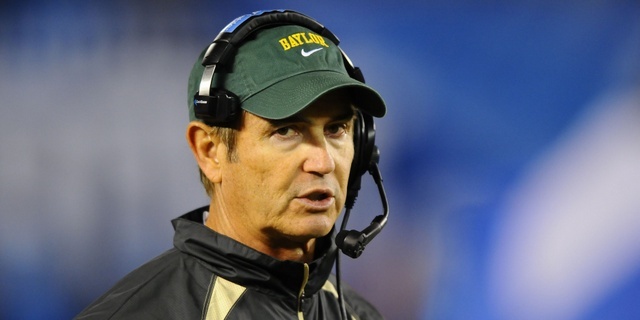The undefeated Baylor Bears, ranked No. 2 in both major polls, are dealing with a huge problem as they vie for a bid to the College Football Playoff. It’s not the one you’re thinking of.
With junior quarterback Seth Russell now shelved for the rest of the season, the focus around Waco has turned to the ability of talented freshman Jarrett Stidham to keep Art Briles’ high-octane offense humming. The Bears currently lead the nation in a host of raw offensive categories, including yards per play (8.3) and points per game (61!). They also rank No. 1 in Offensive S&P+ and No. 2 in Offensive FEI, Football Outsiders’ opponent-adjusted measures of offensive efficiency.
Eye-popping offensive efficiency has been the story since Briles brought Baylor to prominence. Baylor plays the football equivalent of 40 minutes of hell. The Bears run their offense at an ultra-fast tempo, and they make no bones about their intent to score on every single snap. It has turned their offensive output into the stuff of legend, especially as they go through the equivalent of skeleton drills against the likes of Rice and Lamar.
The Bears didn’t start challenging for the top of the Big 12, however, until their defense demonstrated some semblance of a pulse. Between 2011 and 2013, they saw their national Defensive S&P+ ranking move from 95 to 60 to 21. Not coincidentally, the Bears moved up the conference standings.
Regression is showing signs of setting in, though. Last year, the Bears fell to No. 39 nationally in Defensive S&P+. So far this season, Baylor ranks 69th overall.
Baylor’s shock-and-awe mentality extends to its defense. Defensive coordinator Phil Bennett likes to stack the box on early downs to stop the run and get opponents off schedule. In passing situations, the Bears blitz like crazy to force quarterbacks into quick decisions, and their defensive backs play tight, physical coverage out on an island. The objective is to keep the pressure up and get the ball back to Baylor’s quick-strike offense as fast as possible.
The combination of Bennett’s philosophy and better talent on D has turned Baylor into one of the Big 12’s best at stopping the run. In 2013, the Bears gave up 3.5 yards per rushing attempt. They cut that down to 3.2 yards per attempt last year, and they’re at 3.5 so far this season.
Unfortunately for the Bears, they’re having more trouble stopping teams when they take to the air.
In 2013, the Bears’ defense finished third in the Big 12 in passing rating (110.1), allowing just 6.4 yards per attempt. Last year, they dipped to sixth in the conference in passing rating (129.5) while giving up 7.5 yards.
While Baylor’s pass D is putting up 2013-type numbers this year, the Bears still have to face two offenses that rank in the top 10 nationally in Offensive Passing S&P+ in TCU and Oklahoma, along with Oklahoma State’s Air Raid attack. Texas Tech, the most accomplished passing offense they’ve faced so far this season, torched the Bears for more than 500 yards through the air, averaging more than 8 yards per throw. That included a slew of drops which could have led to big plays. For example:
The numbers suggest that opponents have learned to use the Bears’ aggressiveness against them. Baylor gave up 64 passing plays of 15 yards or more in ‘13 and 79 in ‘14. Through seven games, the Bears have allowed 38 such plays this season, with the meat of their schedule still to come.
Perhaps the best indication of the strategy for beating Baylor is first down. In 2013, opponents were averaging 8.3 yards per attempt on first down, with 28 passes of 15 yards or more. That ballooned to 9.3 yards per attempt and 35 passes of 15 yards or more last season.
So far this year, the Bears are giving up 7.1 yards per attempt on first down, with 12 plays of 15 yards or more. Notably, opponents are completing 67.1 percent of their throws on first down, which ranks 107th nationally.
If the Bears stumble down the stretch, the story will undoubtedly be that Russell’s injury torpedoed Baylor’s shot at greatness. Yet, the fact of the matter is that despite the offensive exploits, Baylor looks poorly equipped on the other side of the ball, unprepared to stand up to the Big 12’s best attacks.
The odds are now that the Bears will go down once or twice in November. That likely would have been the case with or without a healthy Seth Russell.

